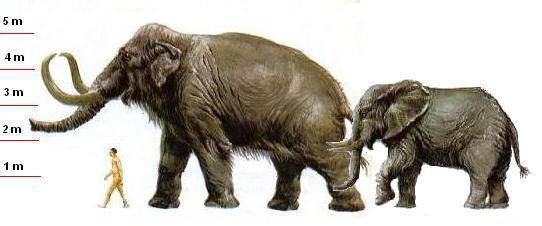| 새로운 사진 | 신문속의 동물소식 | 신기한 동물이야기 | 동물의 소리 | 동물동화상 | 사진 올리기 | 사진 저작권 | English |
|---|
| 재미있는 동물사진 | 괴수/괴어/엽기 동물사진 | 동물이름사전 | 동물목록 | 바깥고리 | 창고입구 | 똑똑누리집 |
|---|
| 이미지 정보 | Original File Name: Shokado or Songhua River Mammoth, Mammuthus-sungari, comparison with man and African elephant.jpg Resolution: 542x226 File Size: 53703 Bytes Upload Time: 2008:01:14 13:08:37 | |
| 올린이 | 이름 (메일주소): Unknown | |
| 사진 제목 | Songhua River Mammoth (Mammuthus sungari) - Wiki | |
 |
| Email : 카드 | 올린이 | 운영자 사진삭제 정보수정 Admin |
| 설명 | Songhua River Mammoth (Mammuthus sungari) - Wiki
Mammuthus sungari
According to the Ibaraki Nature museum, the Songhua River Mammoth -- also known as the Shokako Mammoth in Japanese -- (Mammuthus sungari) was the largest mammoth in the world, surpassing even the Imperial Mammoth in size. The mounted skeleton at the museum reaches an overall height of 5.3 meters and a length of 9.1 meters, with hips more than 2.2 meters wide and tusks 3.2 meters in length. This specimen could have weighed more than 17 metric tons, as heavy as Paraceratherium, making it one of the largest land mammals of all time. The Songhua River Mammoth lived in Northern China during the Late Pleistocene about 100,000 to 10,000 years ago. Its remains have been found in the Gobi Desert. Size Asier Larramendi and P??rez Molina estimated that a Songhua River Mammoth 4.7 meters high at the shoulders would have weighed more than 17 metric tons, or nearly three times heavier than the modern African elephant. Method of estimation To calculate the mammoth's weight, Asier Larramendi created a technique (based on Gregory Paul´s drawings) that consisted of separating the animal into different parts and modeling those parts as cylinders. The volumes of these cylinders can then be calculated and multiplied by the typical density of mammals. To demonstrate the accuracy of the technique, the approach was applied to an African elephant 3.5 meters high. The estimated weight for this animal was found to be 6.4 metric tons, which is consistent with the actual weight of an elephant of that height. Comparison to other large mammals Larramendi applied his model to a 4.5 meters tall Mammuthus trogontherii, getting the result of 12 metric tons. The much smaller figure owes to the fact that M.sungari was nearly a third wider than M.trogontherii. Larramendi then applied the same approach to estimate the mass of the largest Indricotherium found, which was 5.4 meters to the shoulders. The Indricotherium was estimated to weigh 16.8 metric tons, about a half ton less than the M.sungari, due to its more slender frame. If accurate, this would imply that M.sungari was the largest land mammal known to have lived. Paleontologist Gregory Paul has estimated that the largest Indricotherium remains found (two giant vertebrae and a partial central metacarpal) suggest the a height at the shoulders of 4.8 meters. Nevertheless, Paul estimated the mass of the Indricotherium at over 16 metric tons. Larramendi's approach would result in the lower estimate of 14.5 metric tons for this animal. For the mammoths' calculations there would be significant differences as well; Paul estimated a 4.0 meters M.Trogontherii would weigh 11 metric tons, while Larramendi estimated 9 metric tons. http://en.wikipedia.org/wiki/Mammuthus_sungari
| |||
| 댓글 |
| |||||||||||||
| 저작권 정보 | 사진의 저작권은 원저작자에게 있습니다. 동물그림창고는 동물관련 사진을 전시할 수 있는 공간만을 제공합니다.사진을 사용하고자 할 경우에는 저작권자와 협의하시기 바랍니다. |
|
|
|
| |||||||
| CopyLeft © since 1995, 동물그림창고. All rights may be reserved. | ||||||||
Stats